Posts Tagged ‘cats’
Understanding Pet Vaccinations: Ensuring Your Pet’s Health
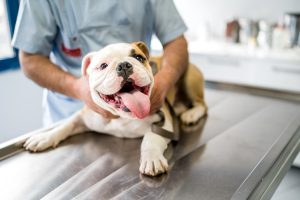 As pet owners, we all want our furry companions to live long, healthy, and happy lives. One of the most crucial aspects of maintaining your pet’s health is ensuring they receive the appropriate vaccinations. At Olsen Veterinary Clinic, we believe in educating pet owners about the importance of vaccinations, the recommended vaccination schedule, and how these preventive measures contribute to your pet’s overall well-being.
As pet owners, we all want our furry companions to live long, healthy, and happy lives. One of the most crucial aspects of maintaining your pet’s health is ensuring they receive the appropriate vaccinations. At Olsen Veterinary Clinic, we believe in educating pet owners about the importance of vaccinations, the recommended vaccination schedule, and how these preventive measures contribute to your pet’s overall well-being.
Why Are Pet Vaccinations Important?
Vaccinations are vital for protecting pets from various infectious diseases, some of which can be life-threatening. These vaccines work by stimulating the immune system to recognize and fight specific pathogens, such as viruses and bacteria, if your pet is exposed to them in the future. Here are some key reasons why vaccinations are essential:
1. Disease Prevention
Vaccines help prevent numerous diseases that can affect pets. For example, canine parvovirus, distemper, and rabies in dogs, and feline leukemia virus and panleukopenia in cats, are all preventable through vaccination.
2. Public Health
Some diseases that affect pets, like rabies, can be transmitted to humans. By vaccinating your pet, you are also protecting yourself, your family, and your community from potential zoonotic diseases.
3. Legal Requirements
In many areas, certain vaccinations, such as rabies, are required by law. Ensuring your pet is up-to-date with their vaccines helps you stay compliant with local regulations.
4. Cost-Effective Health Care
Preventing diseases through vaccination is often far less expensive than treating the diseases once they occur. Regular vaccinations can save you from costly treatments and emergency vet visits.
Recommended Vaccination Schedule
At Olsen Veterinary Clinic, we follow a vaccination schedule that aligns with the guidelines set by veterinary health authorities. Here is a general outline of the recommended vaccination schedule for dogs and cats:
For Puppies and Dogs:
- 6-8 weeks:
- Distemper
- Parvovirus
- Adenovirus (Hepatitis)
- Parainfluenza
- 10-12 weeks:
- Booster for Distemper, Parvovirus, Adenovirus, and Parainfluenza
- Bordetella (Kennel Cough)
- 14-16 weeks:
- Booster for Distemper, Parvovirus, Adenovirus, and Parainfluenza
- Rabies
- 1 year and annually thereafter:
- Annual boosters for Distemper, Parvovirus, Adenovirus, Parainfluenza, and Rabies
- Optional: Lyme disease, Leptospirosis, and Influenza based on your dog’s risk factors
For Kittens and Cats:
- 6-8 weeks:
- Feline Viral Rhinotracheitis (FVR)
- Calicivirus (FCV)
- Panleukopenia (FPV)
- 10-12 weeks:
- Booster for FVR, FCV, and FPV
- Feline Leukemia Virus (FeLV)
- 14-16 weeks:
- Booster for FVR, FCV, FPV, and FeLV
- Rabies
- 1 year and annually thereafter:
- Annual boosters for FVR, FCV, FPV, FeLV, and Rabies
How Vaccinations Contribute to Your Pet’s Well-Being
Regular vaccinations play a crucial role in maintaining your pet’s overall health and well-being. Here’s how:
1. Boosts Immunity
Vaccines strengthen your pet’s immune system, making them more capable of fighting off infections and reducing the severity of illnesses if they do occur.
2. Reduces Disease Spread
By vaccinating your pets, you are helping to control the spread of contagious diseases within the pet population. This is particularly important in communal settings like parks, boarding facilities, and grooming salons.
3. Improves Quality of Life
Healthy pets are happy pets. Vaccinations protect against debilitating diseases that can significantly reduce your pet’s quality of life, ensuring they stay active and vibrant.
4. Longevity
Preventive care, including regular vaccinations, has been proven to extend the lifespan of pets. By safeguarding them against diseases, you are giving your pet the best chance at a long, healthy life.
At Olsen Veterinary Clinic, we are committed to providing the highest standard of care for your pets. Vaccinations are a cornerstone of preventive health care, and we encourage all pet owners to adhere to the recommended vaccination schedules. By doing so, you are not only protecting your pet but also contributing to the overall health of the animal community.
If you have any questions about your pet’s vaccination needs or would like to schedule an appointment, please contact us at Olsen Veterinary Clinic. Together, we can ensure your pet’s health and happiness for years to come.
Unveiling the Smile: Celebrating Pet Dental Health
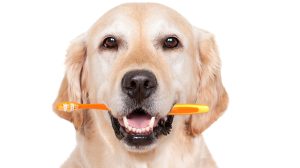 While we often focus on keeping our pets healthy through diet and exercise, dental health tends to be overlooked. However, just like us, our pets need proper dental care to maintain overall well-being. Let’s delve into the importance of dental hygiene for our furry friends and discover how we can ensure they flash those pearly whites for years to come.
While we often focus on keeping our pets healthy through diet and exercise, dental health tends to be overlooked. However, just like us, our pets need proper dental care to maintain overall well-being. Let’s delve into the importance of dental hygiene for our furry friends and discover how we can ensure they flash those pearly whites for years to come.
Why Pet Dental Health Matters
Oral health is a vital aspect of your pet’s overall health and can affect their quality of life in significant ways. Dental issues in pets can lead to pain, discomfort, difficulty eating, and even more severe health problems if left untreated. From plaque and tartar buildup to gum disease and tooth decay, the consequences of neglecting dental care can be serious. Additionally, bacteria from dental problems can enter the bloodstream and potentially affect other organs, such as the heart, liver, and kidneys, making regular dental care crucial for your pet’s longevity.
At-Home Dental Hygiene Tips:
Fortunately, there are several simple yet effective ways to promote good dental hygiene for your furry friends right at home:
- Brushing: Just like humans, pets benefit from regular brushing. Use a pet-specific toothbrush and toothpaste to gently clean their teeth. Start slowly and gradually increase the duration of brushing sessions as your pet becomes accustomed to the routine.
- Dental Chews and Toys: Provide your pet with dental chews and toys designed to promote oral health. These products help reduce plaque and tartar buildup by encouraging chewing and saliva production.
- Healthy Diet: Feed your pet a balanced diet consisting of high-quality food and treats. Avoid giving them sugary or sticky treats, as these can contribute to dental problems.
- Regular Inspections: Take the time to regularly inspect your pet’s mouth for signs of dental issues such as bad breath, swollen gums, or discolored teeth. Early detection can prevent the progression of dental disease.
The Role of Professional Dental Cleanings
While at-home care is essential, professional dental cleanings are also necessary to maintain optimal oral health for your pet. Veterinary professionals have the expertise and specialized equipment to perform thorough cleanings and address any underlying dental issues. During a dental cleaning, your pet will undergo scaling to remove plaque and tartar, polishing to smooth the tooth surfaces, and in some cases, extractions or other necessary treatments. Your veterinarian may also recommend dental X-rays to assess the health of your pet’s teeth and gums below the surface.
Let’s pledge to prioritize our furry companions’ oral health and well-being. By incorporating at-home dental hygiene practices and scheduling regular professional cleanings, we can help our pets maintain healthy smiles and lead happier, healthier lives. Remember, a little care goes a long way in ensuring that your pet’s teeth shine as bright as their personalities! Here at Olsen Veterinary Clinic, we are happy to get you on a regular schedule to ensure your pet’s dental health is strong. Contact our office today!
Nutritional Tips for Pets
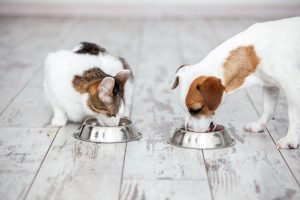 Providing proper nutrition for pets is crucial for the health and well-being of your pets. Here are some general nutritional tips to ensure your pets receive the necessary nutrients.
Providing proper nutrition for pets is crucial for the health and well-being of your pets. Here are some general nutritional tips to ensure your pets receive the necessary nutrients.
- Consult with a Veterinarian: Before making any significant changes to your pet’s diet, consult with a veterinarian. They can provide personalized advice based on your pet’s breed, age, health status and specific needs.
- Balanced Diet: Ensure your pet’s diet is well-balanced and meets their nutritional requirements. This typically includes a mix of proteins, carbohydrates, fats, vitamins, and minerals.
- Quality Commercial Pet Food: Choose High-quality commercial pet food that is appropriate for your pet’s life stage (e.g., puppy, adult, senior). Looke for brands that list a specific meat source as the first ingredient and meet the standards set by relevant authorities.
- Portion Control: Over feeding can lead to obesity and other health issues. Follow the recommended portion sizes on the pet food packaging and adjust based on your pet’s age, activity level, and overall health.
- Fresh Water Ensure your pet has access to fresh, clean water at all times. Hydration is essential for overall health.
- Avoid Human Foods: Many human foods can be harmful to pets. Avoid feeding them chocolate, caffeine, alcohol, onions, garlic, grapes, raisins, and certain artificial sweeteners like Xylitol.
- Monitor Treats: While treats can be a part of your pet’s diet; be mindful of the quality. Treats should not make up more than 10% of your pet’s daily calorie intake.
- Regular Exercise: Combine a balanced diet with regular exercise to maintain a healthy weight and promote overall well-being.
- Special Dietary Needs: Some pets may have specific dietary needs due to allergies, sensitivities, or medical conditions. If your pet requires a special diet, work closely with your veterinarian to find a suitable option.
- Regular Checkups: Schedule regular veterinary check-ups to monitor your pet’s overall health, weight, and nutritional needs. Adjust their diet as necessary based on any changes in health or lifestyle.
- Transition Gradually: If you are changing your pet’s diet, do so gradually over a week to allow their digestive system to adjust. Mix the new food with the old food in increasing proportions.
Remember that individual pets may have unique nutritional requirements, so it is essential to tailor their diet to their specific needs with guidance from a veterinarian. Here at Olsen Veterinary Clinic, we are committed to the health of your pet. Please contact us at any time with questions.
The Importance of Regular Veterinary Check-ups
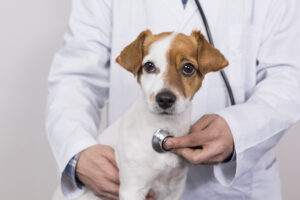 Regular veterinary check-ups are crucial for maintaining the overall health and well-being of your pets. These routine visits play a key role in preventative care and early detection of health issues. Here are some reasons why regular veterinary check-ups are important.
Regular veterinary check-ups are crucial for maintaining the overall health and well-being of your pets. These routine visits play a key role in preventative care and early detection of health issues. Here are some reasons why regular veterinary check-ups are important.
Preventative Care:
Regular check-ups allow veterinarians to administer vaccinations, parasite control, and dental care. Preventative measure can help protect your pet from various illnesses, ensuring they lead a healthier longer life.
Early Detection of Health Issues:
Pets, like humans, can develop health issues that may not be immediately apparent. Regular check-ups enable veterinarians to detect potential health problems early, often before symptoms become severe. Early detection can significantly improve the prognosis and treatment outcomes.
Disease Screening:
Veterinary check-ups may include screenings and tests for common pet diseases. These screenings can help identify conditions such as diabetes, kidney disease, and certain types of cancer in their early stages, allowing for timely intervention.
Dental Health:
Dental issues are common in pets, and they can lead to various health problems if left untreated. Regular veterinary visits often include dental examinations and cleanings, promoting good oral health and preventing dental diseases.
Nutritional Guidance:
Veterinarians can provide guidance on proper nutrition based on your pet’s age, breed, and health condition. A well-balanced diet is essential for maintaining your pet’s overall health and preventing nutrition-related issues.
Behavioral Assessment:
Veterinarians can assess your pet’s behavior during routine visits. Changes in behavior may be indicative of underlying health issues and addressing them early can prevent further complications.
Weight Management:
Maintaining a healthy weight is crucial for your pet’s well-being. Regular check-ups allow veterinarians to monitor your pet’s weight and provide guidance on nutrition and exercise to prevent obesity-related health issues.
Senior Pet Care:
As pets age, their healthcare needs may change. Regular check-ups become even more critical for senior pets to monitor and address age-related conditions, such as arthritis, dental problems, and organ dysfunction.
Client Education:
Veterinary visits are an opportunity for pet owners to learn about their pet’s specific needs, behaviors, and potential health risks. Education from veterinarians empowers pet owners to provide the best care possible.
In summary, regular veterinary check-ups are essential for preventative care, early detection of health issues, and ensuring that your pets lead healthy and happy lives. Establishing a consistent schedule of veterinary visits can contribute significantly to the overall well-being of your beloved companions. Contact our office today to schedule yours or if you have any questions.
10 Pet Health Myths Debunked
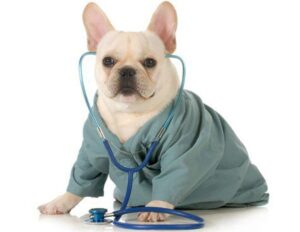 There are several pet health myths that circulate widely. It’s important to separate fact from fiction for the well-being of our furry friends. Here are some common pet health myths debunked.
There are several pet health myths that circulate widely. It’s important to separate fact from fiction for the well-being of our furry friends. Here are some common pet health myths debunked.
1. Myth: A Warm, Dry Nose Indicates Illness
Debunked: A warm, dry nose does not necessarily mean a pet that is sick. Dogs and cats can have varying nose temperatures throughout the day. Factors like weather, hydration, and activity levels play a role.
2. Myth: Cats Always Land on Their Feet
Debunked: While cats have a remarkable ability to right themselves during a fall, it is not foolproof. Cats can still suffer injuries if they fall from a significant height.
3. Myth: Milk Is Good for All Cats
Debunked: Many adult cats are lactose intolerant and feeding them milk can lead to digestive upset and diarrhea. It is best to provide fresh water as their primary source of hydration.
4. Myth: Garlic and Onions are Safe for Dogs and Cats
Debunked: Garlic and onions contain compounds that can be toxic to pets and cause damage to their red blood cells. It’s advisable to keep these foods away from pets.
5. Myth: All Humans Medications Can be Given to Pets
Debunked: Many human medications are toxic to pets. Never give your pet any medication without consulting a veterinarian, as the wrong dosage or type can be harmful and even fatal.
6. Myth: Dogs Will Only Eat Grass if They’re Sick
Debunked: Some dogs eat grass simply because they like the taste or texture. While it’s not entirely clear why dogs eat grass, it’s not always a sign of illness.
7. Myth: Annual Vaccinations Are Always Necessary
Debunked: Some Vaccination needs may vary based on the pet’s health, lifestyle, and age. Some vaccines provide long-lasting immunity, and over-vaccination can have risks. Consult with your vet to create an appropriate vaccination schedule
8. Myth: Pet’s Age Seven Years for Every Human Year
Debunked: The rate at which pets age can vary by species and size. For example, small dog breeds tend to live longer than larger breeds. The one-size fits all calculation is not accurate.
9. Myth: Dry Cat Food Helps Clean Teeth
Debunked: While some dental diets may promote oral health. Relying solely on dry kibble is not a substitute for regular dental care. Brushing your cat’s teeth and providing dental treats can be more effective.
10. Myth: Scratching Furniture Means Cats are Being Destructive
Debunked: Scratching is a natural behavior for cats. Providing appropriate scratching posts and regularly trimming their nails can help redirect this behavior without resorting to punishment
Always give us a call for accurate information and advice tailored to your pet’s specific needs.
Is My Cat Sleeping Too Much? How to Know the Difference Between a Cat Nap and a Problem
 Cats are known for sleeping a lot, and it’s perfectly normal for them to spend a significant portion of their day napping. On average, cats can sleep anywhere from 12 to 16 hours a day and some cats may sleep even more, especially if they are very young or very old. However, if you’re concerned that your cat is sleeping too much and it might be a sign of a problem, here are some things to consider:
Cats are known for sleeping a lot, and it’s perfectly normal for them to spend a significant portion of their day napping. On average, cats can sleep anywhere from 12 to 16 hours a day and some cats may sleep even more, especially if they are very young or very old. However, if you’re concerned that your cat is sleeping too much and it might be a sign of a problem, here are some things to consider:
- Changes in Behavior: Pay attention to any noticelable changes in your cat’s behavior. If your cat is typically active, playful, and social when awake but suddenly becomes lethargic or withdrawn, it could be a sign of an underlying issue.
- Appetite and Thirst: Monitor your cat’s eating and drinking habits. A significant decrease in appetite or a noticeable increase in thirst can be indicators of a health problem.
- Weight Changes: Sudden weight loss or gain can be a sign of various health issues, so keep an eye on your cat’s weight.
- Bathroom Habits: Changes in litter box habits, such as straining to urinate, diarrhea, or constipation, may indicate a problem. Also, observe the color and consistency of your cat’s urine and feces.
- Physical Symptoms: Look for physical signs of distress, such as vomiting, coughing, sneezing, limping, or any obvious discomfort or pain. These can be clues that something is amiss.
- Age and Health History: The age and overall health of your cat can also influence their sleeping patterns. Senior cats may sleep more than younger cats. Consult with your veterinarian to discuss age-related changes in your cat’s behavior.
- Environmental Factors: Ensure your cat’s environment is comfortable and stress-free. Changes in your cat’s living situation, such as moving to a new home, introducing a new pet, or household routine, can affect their behavior and sleep patterns.
- Regular Veterinary Check-Ups: Regular veterinary check-ups are essential for maintaining your cat’s health. If you’re concerned about your cat’s excessive sleeping or any other changes, consult your veterinarian. They can perform a physical examination, run diagnostic tests, and provide guidance of your cat’s specific needs.
Obviously, you know your cat better than anyone. So if you have any concerns or questions about your fur baby, don’t hesitate to contact our office today to set up a visit.
What Is Your Cat Trying to Say? How to Decipher Your Cat’s Body Language
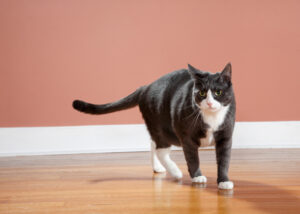 Have you ever talked to animals? Have you ever wanted to converse with your pets’ and interpret their body language ala Dr. Dolittle? Our pets tend to be very important parts of our lives so interpreting their body language can be important to us.
Have you ever talked to animals? Have you ever wanted to converse with your pets’ and interpret their body language ala Dr. Dolittle? Our pets tend to be very important parts of our lives so interpreting their body language can be important to us.
Tail Position: A cat’s tail position can convey various emotions. A relaxed, straight tail usually means your cat is content. A slightly curved tail might indicate curiosity. A puffed-up tail can indicate fear or agitation, while a flicking tail could mean excitement or annoyance.
Ears: Pay attention to your cat’s ears. Forward-facing ears generally indicate curiosity or interest, whe flattened ears suggest fear, anger, or irritation.
Purring: Purring is often a sign of contentment and happiness, though cats can also purr when they’re anxious or in pain.
Body Posture: A relaxed and stretched-out posture signifies comfort and relaxation. An arched back could indicate fear or aggression, while a crouched stance may mean your cat is ready to play or is feeling defensive.
Eye contact: Direct eye contact can be seen as a challenge or a sign of aggression in the cat world. Slow blinking from your cat is ofter a sign of affection and trust.
Kneading: Cats may knead with their paws, pressing them against you or soft surfaces. This behavior is oftern associated with contentment and comfort, as it is reminiscent of their kittenhood when they kneaded their mother’s belly to stimulate milk flow.
Grooming: Grooming is a common self-soothing behavior in cats. If your cat is grooming itself after a stressful event, it could be a sign that it’s trying to calm down.
Remember that individual cats may have different personalities and quirks, so it is essential to observe your cat’s behavior over time to better understand its unique body language. Additionally, context plays a significant role in interpreting cat body language. Consider the situation and overall environment to make a more accurate interpretation of your cat’s emotions and intentions.
If you have any questions about your pet’s quirks or body language please call us at 618-656-5868 or contact us here. We are here to help.
Tips to Keep Your Pets Safe this Independence Day
 A lot of people will be celebrating Independence Day on July 4th. It is important to think about our pets also and plan ahead. As much as we like a fun time celebrating, a lot of pets are scared to death with the fireworks and crowds. It is important to talk to your veterinarian about possibly getting some sedatives to relieve the anxieties associated with them and get advise from them to find out what might be best. It is best to leave your pets inside with the shades pulled down and maybe the tv or radio playing to try and muffle the explosions of the fireworks. Several communities have firework shows that are fantastic to watch, however LEAVE YOUR PET AT HOME. The loud reports can scare the pets and make them a nervous wreck.
A lot of people will be celebrating Independence Day on July 4th. It is important to think about our pets also and plan ahead. As much as we like a fun time celebrating, a lot of pets are scared to death with the fireworks and crowds. It is important to talk to your veterinarian about possibly getting some sedatives to relieve the anxieties associated with them and get advise from them to find out what might be best. It is best to leave your pets inside with the shades pulled down and maybe the tv or radio playing to try and muffle the explosions of the fireworks. Several communities have firework shows that are fantastic to watch, however LEAVE YOUR PET AT HOME. The loud reports can scare the pets and make them a nervous wreck.
Talking about celebrations, there is usually a lot of good food for people, but avoid allowing your pet to counter surf and eat the table food. Some foods such as grapes are toxic for pets, while other greasy and fatty foods may lead to a gastric illness like pancreitis. These illnesses might then require a trip to see your veterinarian and possibly be costly and deadly.
If you and your family are around water during the holiday, it is important to have a life jacket handy for your pet, as not all dogs are great swimmers. Whether it is on a lake or in the pool, the dogs may tire and then start to struggle and panic. A life jacket for your pet may be able to keep your pet safe.
We are happy to have a conversation about any concerns you have. Make sure to protect your furry companion this summer. Contact our offices today!
How to Choose the Right Flea and Tick Medicine for Your Dog
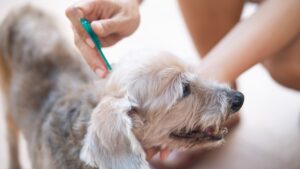 With the weather being nice, people and pets are tired about being cooped up inside. They are starting to enjoy the fresh air, the calm breezes in their face and the warmth of the sun. But whether it is a walk in the park, a weekend camping along the lake or even lounging around your front yard, fleas and ticks could be waiting to latch onto your pet and hitch a ride. So because of this, application of a flea and tick control or collar is essential to prevent them from infesting your home.
With the weather being nice, people and pets are tired about being cooped up inside. They are starting to enjoy the fresh air, the calm breezes in their face and the warmth of the sun. But whether it is a walk in the park, a weekend camping along the lake or even lounging around your front yard, fleas and ticks could be waiting to latch onto your pet and hitch a ride. So because of this, application of a flea and tick control or collar is essential to prevent them from infesting your home.
There are many factors to consider when choosing the optimal product. One must decide if they want a collar, topical or chewable tablet. Each one has their pro’s and con’s about them. The collars and topical products such as Frontline or Advantage have been around a lot longer and may be less expensive to buy, but we have seen breaks in protection because the fleas and ticks have gained resistance or the product has not been used properly. Some of those products are approved by the EPA so they might not be safe to use on your pet. Recently new products such as Nexguard or Bravecto have been developed that are taken orally. Because they are newer products, the fleas and ticks have not developed a resistance to them. Also since they are ingested, they are approved by the FDA to assure their safety to the pet.
There are several oral products available like Simperica Trio that will also control other parasites, along with fleas and ticks. So they may be more expensive but be more convenient in the long run.
The best thing to do is to have a conversation with your vet about what is best for your pet, as well as what works for you financially. We are happy to have a conversation about any concerns you have. Prevention is key, so make sure to protect your furry companion this summer. Contact our offices today!
Cat Safety Tips: How to Protect Your Furry Companion
 Many of us have those 4-legged feline friends that love to hunt and no amount of domestication has changed their inherent desire to patrol their domain in the hunt for prey. We have all seen the look of pure joy on our cat’s faces when they watch birds and small rodents from the window. And because cats are naturally curious, they love to explore. That is why some people allow their cats to spend considerable time outdoors. The downside it that the outdoors has many dangers that can linger and it is our job as responsible owners to keep them safe.
Many of us have those 4-legged feline friends that love to hunt and no amount of domestication has changed their inherent desire to patrol their domain in the hunt for prey. We have all seen the look of pure joy on our cat’s faces when they watch birds and small rodents from the window. And because cats are naturally curious, they love to explore. That is why some people allow their cats to spend considerable time outdoors. The downside it that the outdoors has many dangers that can linger and it is our job as responsible owners to keep them safe.
While most experts would recommend that the best thing to do would be keeping them indoors, you can allow them to get some fresh air in a relative safe environment away from predators that would prey on your cat and making sure that they are protected when they go outside.
Some owners may try to leash train their cat. This is one of the easiest means of monitoring where your cat goes because you get to go along for the walk. Cat’s generally dislike harnesses, so they will need to be made accustom to using them first. This may entail having the harness on inside and provide positive reinforcement with treats. Supervised outdoor time is a great way to bond with your cat and give her the mental stimulation that her wild instincts crave.
Whether you allow her to roam free or keep her as close as possible, it is important for the cat to either have a microchip or some other form of identification on your pet. If you use a collar, a safety collar with an elastic panel will allow your pet to break free if it gets caught.
To allow cats to have the ability to go outside, some owners make a catio that keep predators out and their pet in. This can serve as an outdoor playground within the vicinity of your home. You can feel safe knowing where it is and that she is not running out into the street or being picked up by predator birds or other mammls.
If your cat goes outdoors, it is at risk to the diseases and parasites that the outdoor feral cats have. So it is important to have your pet’s vaccines updated and kept on flea and tick control.
Your back yard can be dangerous to your pet if you have planted some toxic plants for landscaping. Plants like lillies may look nice in your back yard, but they can be toxic to your pet. It is important to make sure that anything potentially toxic and dangerous be picked up and secured. I would also recommend not having mouse poisons available because not only would the poison be toxic, eating a dead mouse that has succumbed to the poison may be also lethal to the cat.
It is important to have a regular dinner time. That way when the cat’s return for it evening meal, they will be able to be locked up for the evening. This will protect her from the nightly predators and allow her to go on daily patrol the next morning.
For any more questions on cats, or any other furry companion, contact our offices today!
